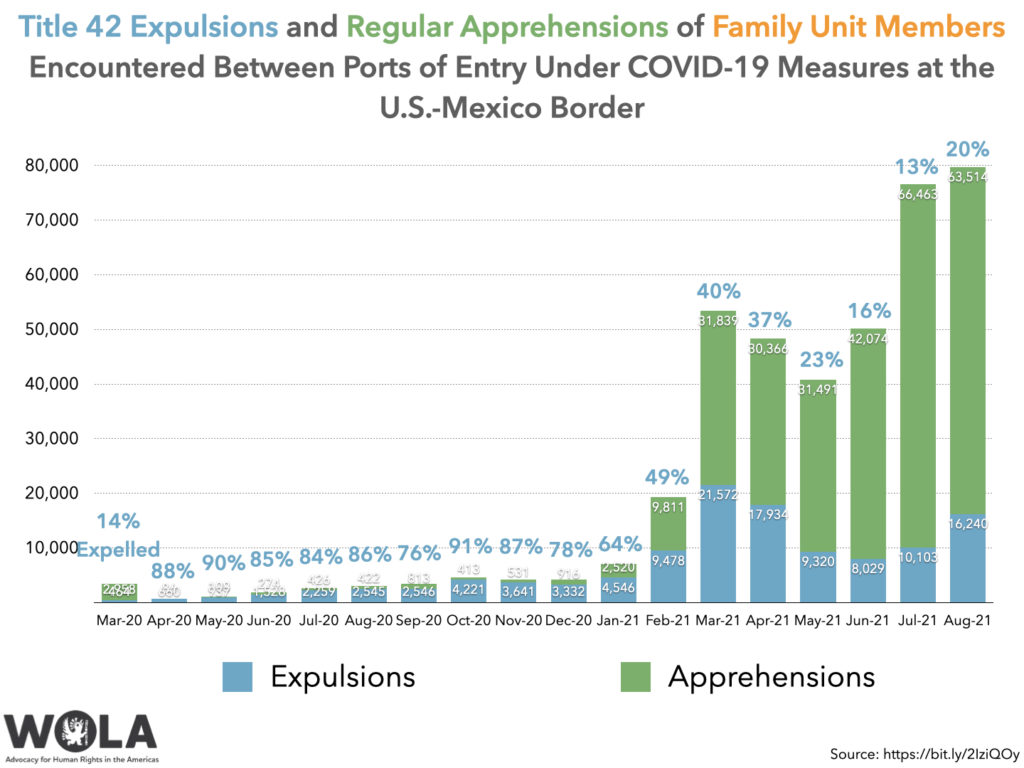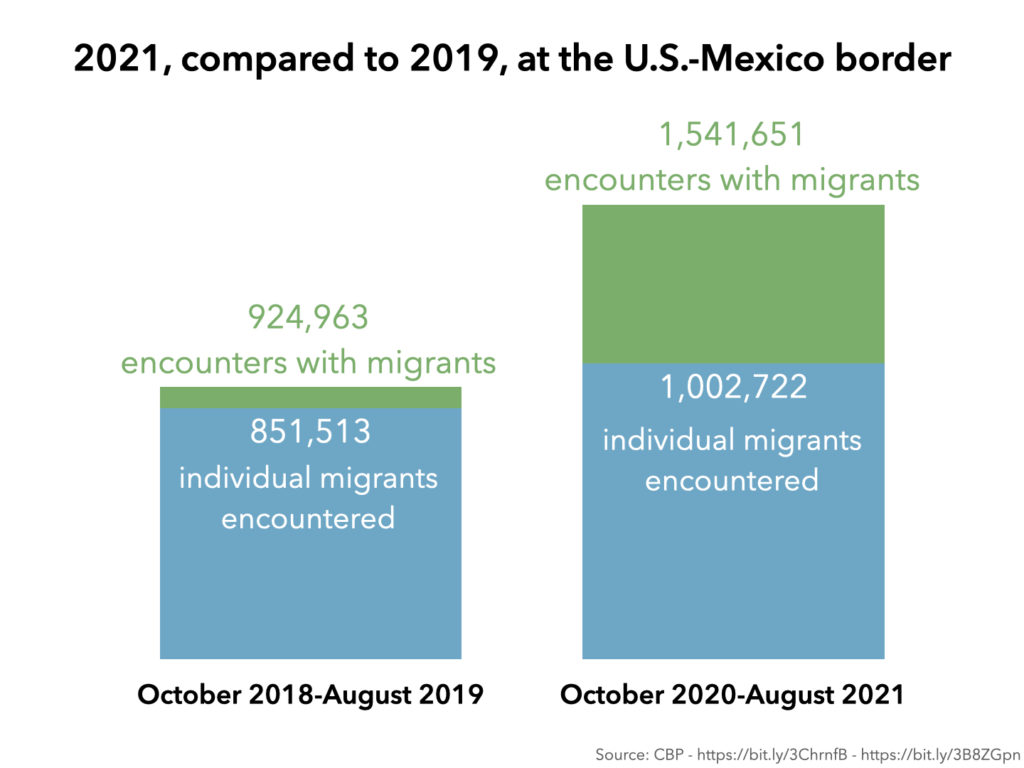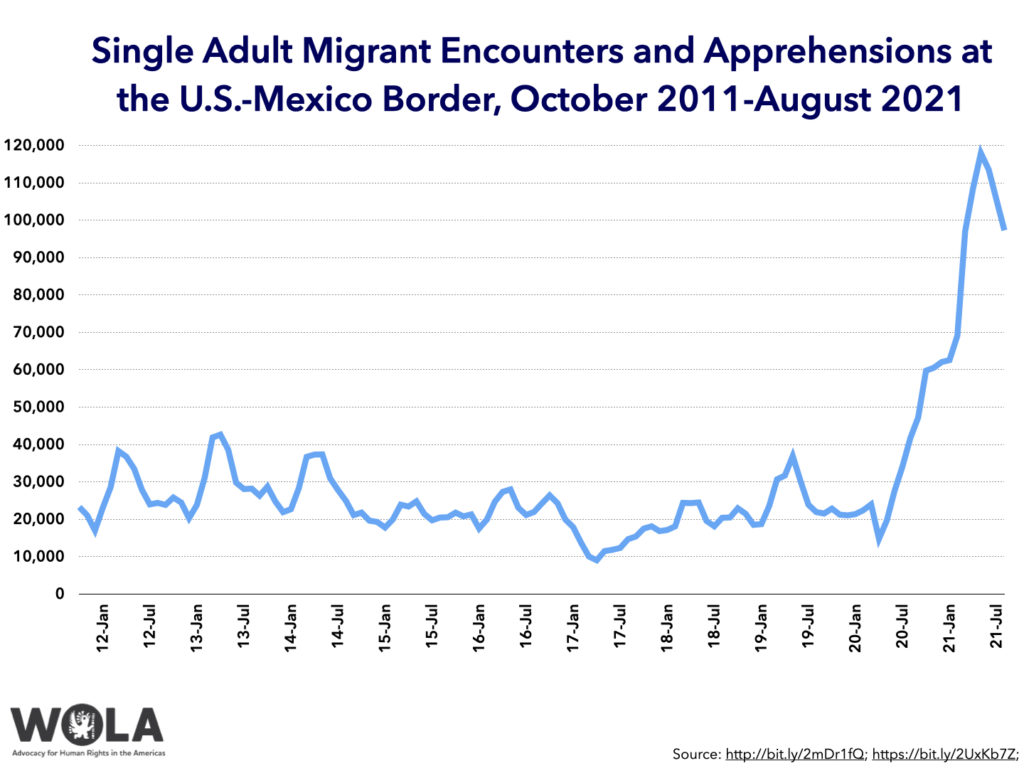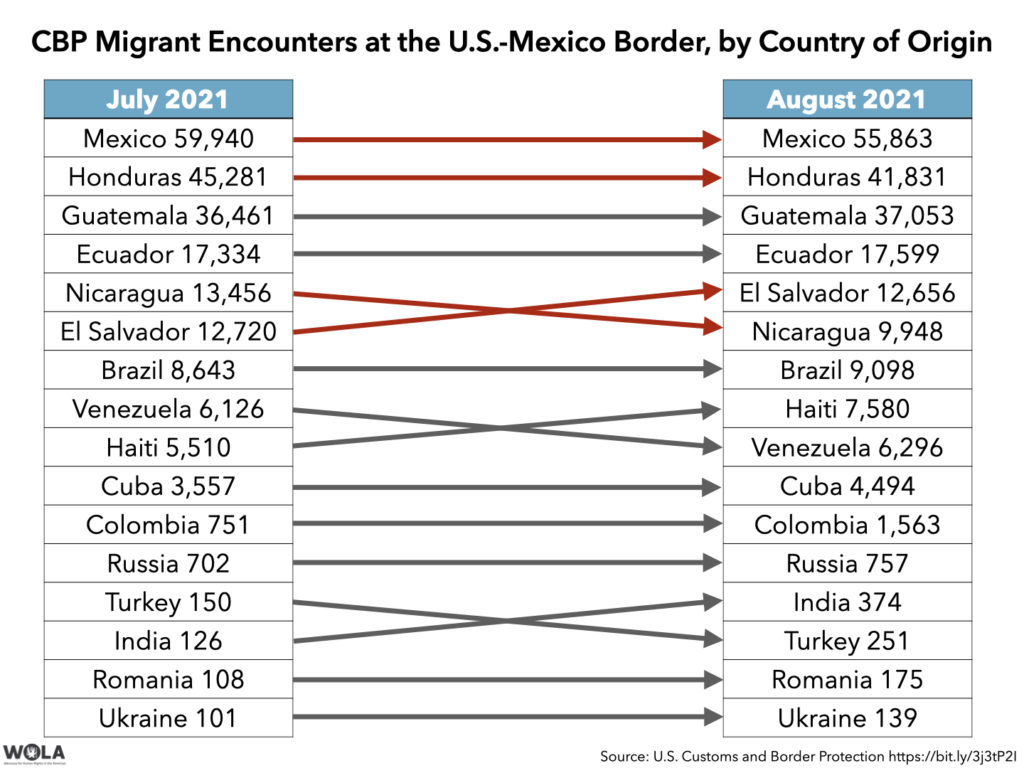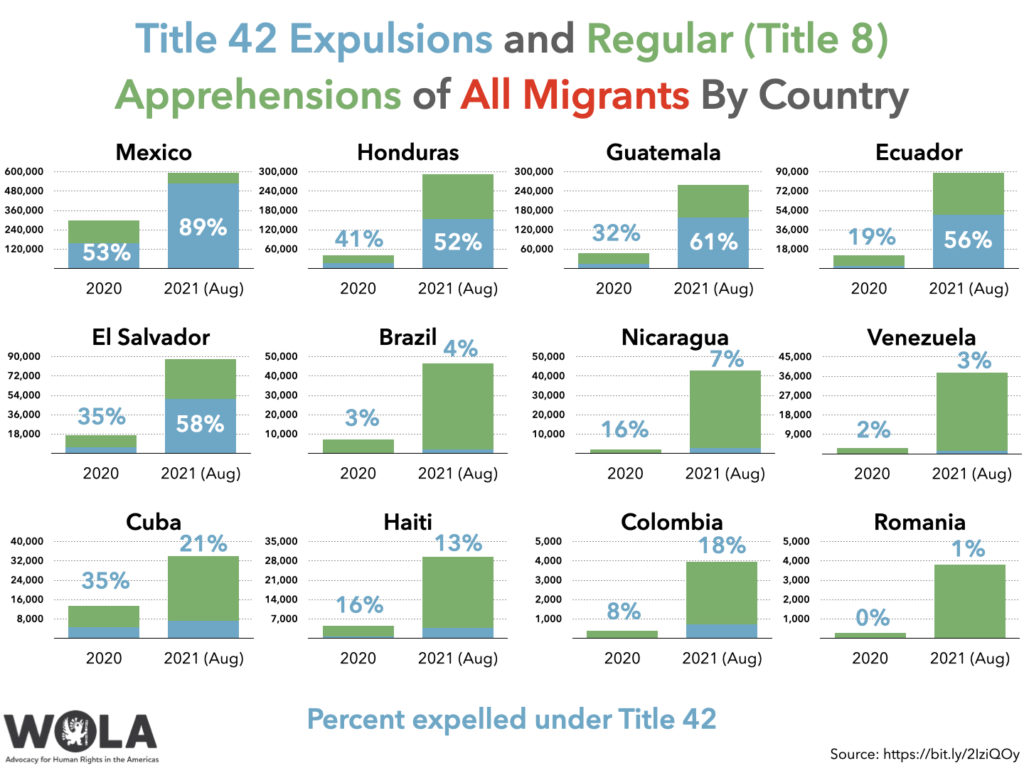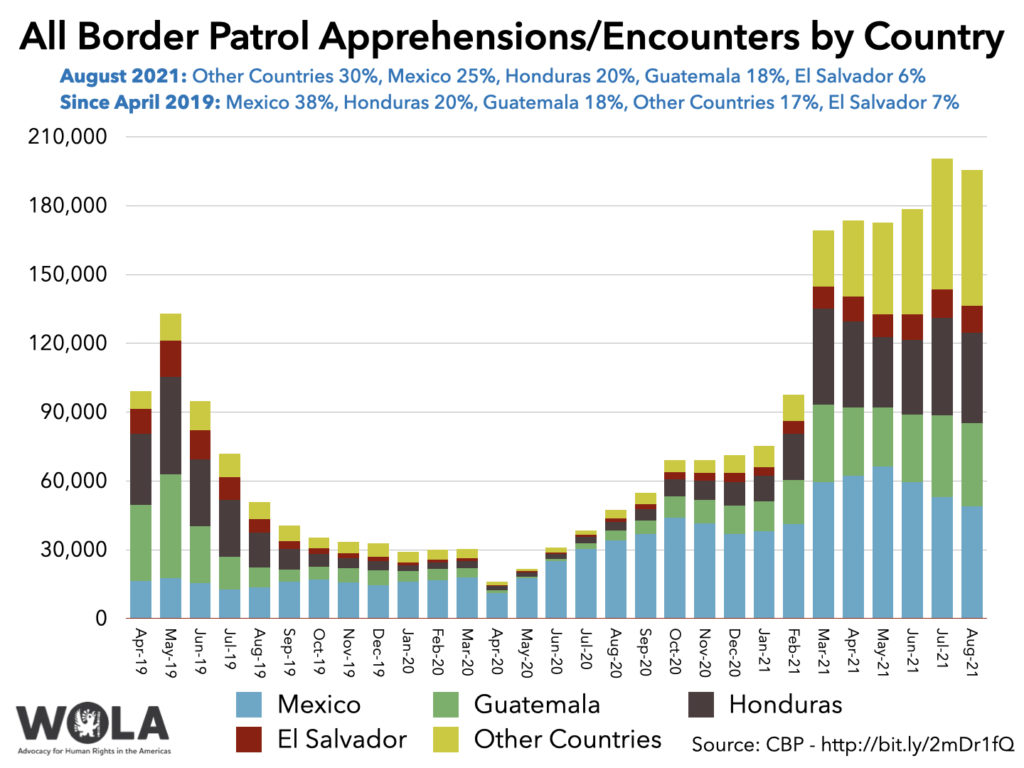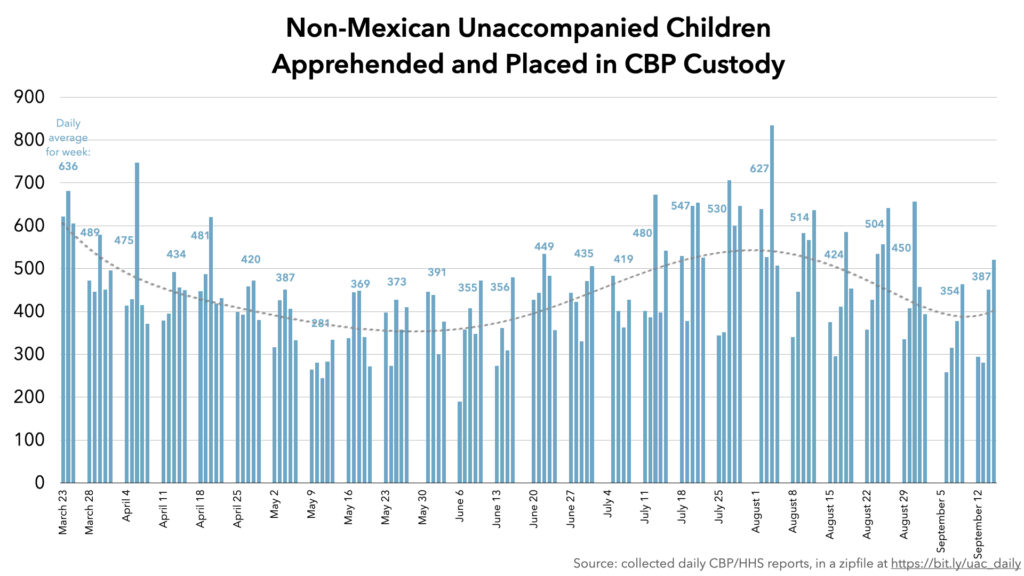With this series of weekly updates, WOLA seeks to cover the most important developments at the U.S.-Mexico border. See past weekly updates here.
Subscribe to the weekly border update
Support the Beyond the Wall campaign
Judge orders halt to family expulsions
A September 16 ruling from Washington DC District Court Judge Emmet Sullivan blocks the Biden administration from using the “Title 42” pandemic expulsions policy to expel members of migrant families encountered at the U.S.-Mexico border. Judge Sullivan stayed his decision for 14 days in order to give the administration a chance to appeal or to adjust the way it implements Title 42. If his ruling stands, undocumented migrant parents arriving at the border with children must once again be processed under regular immigration law, which means if they ask for protection in the United States, they must be allowed to seek asylum.
“Title 42” refers to an old, little-used quarantine authority that the Trump administration implemented in March 2020, along with COVID-19-related border shutdowns, and the Biden administration has kept in place. In the name of preventing disease spread, Customs and Border Protection (CBP) uses Title 42 to expel—eject from the United States with minimal processing, often in a matter of hours—as many apprehended migrants as possible, usually without even offering an opportunity to ask for asylum or protection. Mexico accepts many expulsions of migrants at the border from El Salvador, Guatemala, and Honduras, along with citizens of other countries who have any visas or migratory status in Mexico.
Between March 2020 and August 2021, CBP has used Title 42 to expel 1,163,582 people, including 1,027,506 single adults, 118,466 family unit members, and 15,915 unaccompanied children.
Most of these expulsions happened during the Biden administration. Since February 2021—Joe Biden’s first full month in office—CBP has used Title 42 to expel 704,009 people, including 610,249 single adults, 92,676 family unit members (the expulsions that Judge Sullivan’s decision would stop), and 32 unaccompanied children.
In November 2020, ruling on an earlier challenge to Title 42, Judge Sullivan had halted all expulsions of unaccompanied children. This ruling was overturned on appeal in late January 2021, but the Biden administration refused to resume expelling children, alone, to their home countries. (Unaccompanied Mexican children are still deported alone.)
Judge Sullivan’s latest decision comes after a month (August 2021) that saw CBP expel the largest number of family members (16,240) since April: 20 percent of those encountered were expelled last month, the largest percentage since May. Most families who are not expelled are admitted into the United States to await adjudication of their asylum claims, a process that often takes years due to immigration court backlogs.
Under Judge Sullivan’s ruling, the blue part of this chart would shrink to zero.
The ban on family expulsions is a victory for the American Civil Liberties Union (ACLU) and the other organizations involved in litigation dating back to the final month of the Trump administration. The Biden administration and ACLU had put this case on hold until August 2, when the Department of Homeland Security (DHS)—citing the persistence of COVID-19 and its Delta variant—abandoned plans to phase out family expulsions, leading the organizations to resume litigation.
“We hope the Biden administration has no plans to appeal and continue to place families in grave danger,” Lee Gelernt, the ACLU’s lead lawyer in the Title 42 families challenge, had told CBS News on September 16. Nonetheless, on September 17 the administration moved to appeal Judge Sullivan’s ruling.
This is not completely surprising: the Wall Street Journal pointed out that DHS’s assistant secretary for border and immigration policy had defended Title 42’s implementation in an August 2 court declaration. That official, former Democratic Senate Judiciary staffer David Shahoulian, resigned his post this week, citing personal reasons.
Single adults, for now, can still be expelled under Title 42; CBP expelled 77 percent of single adults it encountered in August 2021.
Migration “levels off” in August
That August 2021 number comes from a September 15 CBP release and data update pointing to a 2 percent drop, from July, in the agency’s “encounters” with undocumented migrants at the U.S.-Mexico border. CBP reported 208,887 encounters with 156,641 individual migrants during August, the second-largest total (after July) in 2021 and one of the largest monthly totals this century.
Several trends stood out in our analysis of this data.
- Measured by individual migrants, not encounters, the first 11 months of fiscal year 2021 are about 18 percent ahead of the pace set in 2019, which at the time was the busiest year for migration at the border since 2007.
- Encounters with single adults declined for the third straight month. Single adults are now down 15 percent from May, though their numbers remain far higher than in the decade before the pandemic. Numbers of single adults shot upward after March 2020, in part because rapid Title 42 expulsions trigger repeat attempts by adult migrants who wish to avoid being caught. Of the migrants the agency encountered in August, CBP had already encountered 25 percent at least once already this year. (CBP’s September 15 statement mentions a “Repeat Offender Initiative,” begun in July, that seeks to prosecute more repeat border crossers.)
- Encounters with family unit members grew by 3.6 percent over July.
- Encounters with unaccompanied children stayed near July’s record levels, dropping by just 0.6 percent—though, as noted below, new arrivals of unaccompanied children have declined in late August and so far in September.
- 47 percent of those encountered by Border Patrol were expelled in August, the same proportion as July.
- As noted above, Title 42 expulsions of family unit members increased from July to August. “The number of encounters with family unit individuals so far this fiscal year (415,185),” CBP reports, “remains below the number of encounters at the same point in Fiscal Year 2019 (505,102).”
- Migrants from Mexico, Honduras, Nicaragua, and El Salvador declined somewhat from July to August (red arrows in the graphic below). All other nationalities with over 100 monthly encounters increased. The largest proportional increases were migrants from Colombia and Haiti.
- There is remarkable variation, by country, in which nationalities are expelled most often under Title 42.
- Fully 30 percent of encountered migrants—and 39 percent of family unit members—are from countries other than Mexico or Central America’s “Northern Triangle.” We have seen no record of that ever happening before this year.
- Daily reports from CBP (collected here as a large zipfile) point to declining arrivals of unaccompanied children since mid-August, to their lowest numbers in three months.
Data as of September 10 viewed by NBC News point to an overall decline in migration at the border over the prior three weeks: “the 21-day average of immigrants stopped crossing the U.S.-Mexico border by Customs and Border Protection was 6,177 per day, down from 7,275 in mid-August.” The daily number of Title 42 expulsions, however, increased over the past month—from 2,550 per day on August 11 to 2,733 per day on September 10.
This recent decline in migration at the border, however modest, means that “pressure on DHS from the White House to get a handle on migration across the southern border has cooled over the past two weeks,” a “source directly involved with internal discussions” told NBC. The source said that this has allowed DHS to devote more bandwidth to processing Afghan evacuees.
As thousands of mostly Haitian migrants arrive in rural Del Rio, Texas state government escalates crackdown
As of mid-September, migration is clearly not declining in at least one part of the border. The border sector centered on the town of Del Rio, Texas (population 40,000, across the Rio Grande from Ciudad Acuña, Coahuila), is where CBP encountered 69 percent of Haitian migrants in August, along with 55 percent of Cubans and 64 percent of Venezuelans. The flow to Del Rio—which migrants and smugglers often view as a safer, if very remote, route—is pronounced: while nearly 20,000 Haitians came to Del Rio between October and August, only 12 (twelve) came to south Texas’s very busy Rio Grande Valley sector.
This week, Del Rio has seen a further increase in migrant arrivals, overwhelming CBP’s local processing capacity. As of the evening of September 16, the town’s mayor, Bruno “Ralphy” Lozano, was tweeting that 10,503 migrants—perhaps 70 percent Haitian, but also many Cubans, Nicaraguans, and Venezuelans—were waiting under the Del Rio-Acuña border bridge for Border Patrol to process them. That number, the mayor said, was up from 8,200 that same morning. This is up from 2,500 on September 11, the sheriff of surrounding Val Verde county told the Texas Tribune.
The migrants’ wait to turn themselves in—in most cases, to apply for asylum—may take up to five days, several told Reuters. U.S. border agents are giving each person or family unit a ticket with a number that they will eventually call.
Once processed with an asylum claim, the majority will probably be allowed to remain in the United States to await that claim’s adjudication. Logistical and consular issues make it difficult for CBP to expel migrants to Port-au-Prince, Havana, Managua, or Caracas. However, on September 15 DHS sent a deportation flight to Haiti for the first time since August 14, when a 7.2 magnitude earthquake caused widespread devastation in the Caribbean nation.
The migrants in Del Rio are being concentrated outdoors where heat is in the high 90s; water, food, and sanitary facilities are scarce; and social distancing is difficult. Migrants with CBP’s “tickets” have been wading the knee-deep river back to Acuña to buy food, water, and other provisions on the Mexican side. “CBP is scrambling to send additional agents to Del Rio to help process the migrants,” the Washington Post reports. Pictures and footage from the area are striking.
Mayor Lozano told the Post that the migrants have been arriving on buses from elsewhere in Mexico to Ciudad Acuña. “It just sounds like there’s an off-grid bus system that’s not registered with the Mexican government that are driving these individuals north,” he observed.
The situation in Del Rio has drawn the attention of conservative media (Fox News battled CBP for the right to shoot drone footage) and figures like former Trump advisor Stephen Miller.
One of the most vocal proponents of a hardline approach to asylum-seeking migration, Texas governor Greg Abbott (R), announced on September 16 that he had directed state police and guardsmen “to surge personnel and vehicles to shut down six points of entry along the southern border to stop these [migrant] caravans from overrunning our state.” Abbott added that “The border crisis is so dire that the U.S. Customs and Border Protection is requesting our help as their agents are overwhelmed by the chaos.”
It wasn’t clear what Gov. Abbott was talking about: state law enforcement agencies do not have the authority to shut down border ports of entry, which are run by the federal government. CBP spokespeople said they had made no requests to Texas for help, and had no plans to shut down ports of entry. Later on the 16th, Abbott reversed himself, claiming that the Biden administration “has now flip-flopped to a different strategy that abandons border security.”
Abbott, meanwhile, has plans to divert more than $2 billion into border security efforts over the next year, expanding a package of crackdowns, begun in March, that he calls “Operation Lone Star.” He has deployed Texas state police and National Guard personnel to the border zone, giving soldiers a rare power to arrest people. He plans to use state funds to build border fencing where landowners allow it, and the Texas Facilities Commission just signed an $11 million contract with two firms charged with planning and design of barriers.
In a program first rolled out near Del Rio, Abbott ordered police and guardsmen to arrest migrants found on state and private land, so that they may be charged with, and jailed for, the crime of trespassing. Hundreds of migrants—including some who turned themselves in with the expectation of asking for asylum—have been jailed at a facility in Dilley, Texas, and now at a second prison in Edinburg.
Migrants initially jailed in July are now being released, often with dropped charges. It is unclear what happens to them next: because they haven’t committed violent offenses, they are not a priority for ICE, and because they’ve been in the country for a while, they are not a priority for CBP. Texas authorities have started releasing formerly jailed migrants at a gas station bus stop in Del Rio. Under a new process agreed last week, CBP will process migrants released from Texas jails. Some who have entered this process so far have been deported, but roughly half have been released from CBP custody to await adjudication of their asylum cases within the United States.
In south Texas’s Rio Grande Valley region, local station KRGV reports, “Operation Lone Star” has meant a sharp increase in often frivolous traffic stops as state police crowd local roads. Citations for “having anything on the car’s windshield,” among other examples, are up 1,060 percent. KRGV cites a 2014 study by the El Paso-based Border Network for Human Rights, which found that during past deployments to the Rio Grande Valley border region, Texas state police oversaw a 127 percent increase in traffic citations for Hispanic drivers—and a 40 percent drop in citations for White drivers.
Links
- As required by the judge in the case, the Biden administration has submitted its first monthly report documenting its “good faith efforts” to restart the Trump administration’s Migrant Protection Protocols, or “Remain in Mexico,” program.
- The report explains that while Remain in Mexico hasn’t restarted yet, an “interagency task force” is “meeting regularly to quickly and efficiently rebuild the infrastructure and reapportion the staffing required.”
- Rebuilding facilities to hold immigration hearings at ports of entry “will cost approximately $14.1 million to construct and $10.5 million per month to operate.”
- Mexico, the report notes, hasn’t agreed yet to take back any migrants. Discussions between the United States and Mexico must determine where returns could happen, how many people could be returned, demographic questions (like whether Mexico would take families or would limit ages of children sent back), and how Mexico would support those made to remain in the country for months or years to await their U.S. hearing dates.
- 68 organizations, including WOLA, sent a letter to President Biden and DHS Secretary Alejandro Mayorkas urging a series of policy changes and measures to reduce extreme heat-related deaths of migrants on U.S. soil, which have totaled more than one per day so far this year.
- Mexican migration authorities apprehended 150 Haitian migrants near the Guatemala border-zone city of Tapachula, Chiapas on September 11, then expelled them into Guatemala.
- As Mexican immigration agents and National Guard personnel continue to block asylum-seeking migrants from leaving Tapachula, Chiapas Parelelo notes migrants’ increasing use of northward routes through central Chiapas, like the Angostura Reservoir region.
- “Women and children seeking refuge instead find themselves incarcerated in detention centers or prisons for migrants that are paid for with our tax dollars, whether in Tapachula (the prison-city as those women call it) or in Iztapalapa or Tijuana,” reads a letter from dozens of women’s rights groups and activists from Mexico and several other countries.
- The coordinator of Mexico’s refugee agency COMAR, which as of August had already broken its single-year record for asylum requests, pleads for a budget increase in an interview with Mexico’s El Universal.
- An Alabama National Guard soldier assigned to the border security mission was arrested near McAllen, Texas, while transporting about a kilogram of cocaine in a Border Patrol vehicle.
- At least 600 migrants per day are passing from Colombia through Panama’s dangerous, ungoverned Darién Gap region right now, and about a quarter of them are children, the Associated Press reports.
- Ciudad Juárez has reappointed a former municipal police chief, César Omar Muñoz, who had led the force from 2013 to 2016. Human rights groups accuse Muñoz of ordering human rights violations and defense officials have alleged that he has organized crime ties, Vice reports.
- “It hurts my heart” to see the effects in Mexico of cross-border arms trafficking from the United States, where weapons are easy to obtain, said Ken Salazar, the new U.S. ambassador to Mexico. The Ambassador added that there is a need for “a new bilateral migration model,” though he did not offer specifics.
- The New York Times looks at residents’ disagreements about border wall construction in the Rio Grande Valley border town of Los Ebanos, Texas.
- A New York Times essay by journalist Lauren Markham recalls that past U.S. experiments with “alternatives to detention” programs for asylum seekers, including social work support, have achieved near 100 percent appearance at court dates.
- “The Central American migrants crossing Mexico have undoubtedly been subjects from whom everyone has taken everything they can,” author and journalist Óscar Martínez tells Mexico’s SinEmbargo. “Both the state and organized crime, the small gangs of assailants who kill and rape. The passage through Mexico is a kind of enormous toll where the decision to seek a better life has to be paid with much suffering.”
- “Few people will throw stones at a tree planting program, but Guatemalans aren’t going to stop leaving home because they got temporary work planting trees,” writes former WOLA executive director Joy Olson at Reforma’s Mexico Today. “The tree program is about Mexico looking like it is responding to a migration crisis without actually doing much. The US needs to provide serious numbers of work visas to Central America, and Mexico should push them to do it.”

 Adam Isacson
Adam Isacson
